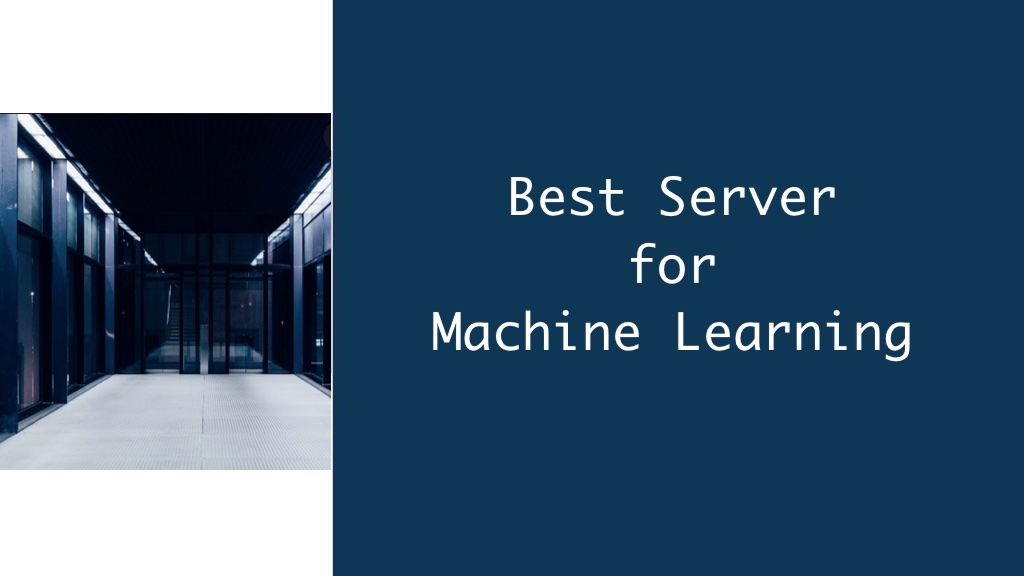Machine learning (ML) has become the driving force behind groundbreaking advancements across various industries. However, the success of any ML project hinges on a crucial component – the server. Selecting the right server lays the foundation for efficient training, smooth deployment, and ultimately, the impactful results your ML model is designed to deliver.
What Makes a Great ML Server?
Unlike web servers handling traffic, ML servers shoulder demanding tasks: processing massive datasets, training complex models, and performing intensive computations. Here’s what separates a good server from a great ML powerhouse:
- Processing Power: The heart of the matter – a powerful Central Processing Unit (CPU) with high core count and clock speed is essential for handling complex calculations involved in ML algorithms.
- Memory Capacity: Large datasets and intricate model architectures necessitate ample RAM (Random Access Memory) to ensure smooth data processing and model execution.
- Storage Options: From storing raw data to housing trained models, sufficient storage space (ideally a combination of high-speed SSDs and large-capacity HDDs) is critical.
- Graphics Processing Unit (GPU) Power: For deep learning tasks, GPUs act as accelerators, significantly speeding up training. Consider the number of GPUs, their memory capacity, and compatibility with your chosen deep learning framework.
- Scalability: As your projects evolve and data volumes increase, the server should offer the ability to scale up resources (CPU, memory, storage) seamlessly to meet growing demands.
Understanding Your Options: Server Types for ML
The ideal server type depends on your specific needs and budget. Here are the main contenders:
- Central Processing Unit (CPU) Servers: Cost-effective and well-suited for basic ML tasks or projects with limited data. However, they can bottleneck for computationally intensive deep learning applications.
- Graphics Processing Unit (GPU) Servers: The go-to choice for deep learning. GPUs excel at parallel processing, significantly accelerating training times. Multiple GPUs can be incorporated for even faster training.
- Cloud Servers: Offer flexibility and scalability – you can pay for the resources you use and easily scale up or down as needed. Ideal for those starting out or with fluctuating workloads.
- High-Performance Computing (HPC) Clusters: For large-scale, distributed training of complex models, HPC clusters leverage multiple interconnected servers, providing unparalleled processing power but also requiring significant investment and expertise.
Hardware: Essential Considerations
While hardware is paramount, other factors contribute to a successful ML server setup:
- Operating System: Choose an OS that supports your chosen ML frameworks and libraries (e.g., Linux for most deep learning frameworks).
- Networking: Ensure a high-bandwidth, low-latency network connection to facilitate efficient data transfer, especially when working with large datasets or collaborating with remote teams.
- Cooling System: High-performance servers generate significant heat. A robust cooling system is essential to maintain optimal operating temperatures and prevent hardware damage.
Exploring Deployment Options: Cloud, On-Premise, or Hybrid?
The server deployment model significantly impacts cost, scalability, and control. Here’s a breakdown of the three main options:
- Cloud Servers: Cloud providers offer pre-configured virtual servers with flexible scaling options. This is a cost-effective solution for short-term projects or those with fluctuating resource demands. However, cloud options might incur ongoing costs and potential latency issues.
- On-Premise Servers: Owning and managing your physical servers provide maximum control and security. This approach is ideal for projects requiring high performance, data privacy, or customization. However, on-premise servers involve upfront costs and ongoing maintenance.
- Hybrid Model: A hybrid approach combines cloud and on-premise servers, offering a balance between flexibility and control. You can leverage the cloud for training or resource-intensive tasks while keeping sensitive data on-premise.
The Perfect Fit: Choosing the Right Server for Your Project
Selecting the best server requires careful consideration of your project’s specific requirements. Here’s a roadmap to guide you:
- Define Your Needs: Identify the type of ML tasks you’ll be performing, the size and complexity of your datasets, and the expected growth of your project.
- Evaluate Your Budget: Determine how much you’re comfortable investing in hardware upfront and consider ongoing maintenance costs.
- Research and Compare: Explore different server options, considering CPU/GPU specifications, memory capacity, storage options, and scalability features.
- Seek Expert Advice: If needed, consult with data science professionals or experienced system administrators for tailored recommendations.
- Scalability: Consider future project growth and choose servers that allow for easy addition of resources like CPUs, memory, or GPUs as your needs evolve.
- Cooling and Power Consumption: High-performance servers generate significant heat and require efficient cooling systems. Factor in energy efficiency to minimize operational costs.
- Software Compatibility: Ensure your chosen server supports the operating system and machine learning frameworks you plan to use (e.g., TensorFlow, PyTorch).
- Technical Support: Reliable technical support from the server vendor can be invaluable for troubleshooting hardware issues or optimizing performance.
By carefully considering these factors, you can choose the server that empowers your machine learning projects to flourish. Remember, the perfect server is an investment that fuels innovation and unlocks the true potential of your ML endeavors.
